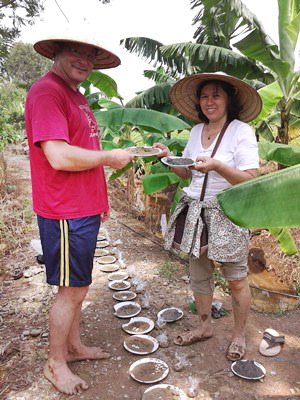Arsenic contamination is heterogeneous but widespread in the Red River and Mekong River deltas of Vietnam, where more than 10 million people depend on arsenic-impacted aquifers for drinking and irrigation water. Many of these wells are private tube wells with dangerous levels of arsenic. The Vietnamese researchers conducting this project have been documenting the extent and nature of this contamination for many years in collaboration with scientists from around the world.
Development and urbanization have facilitated the installation of numerous domestic water supplies that draw heavily upon low-arsenic parts of the aquifer. These wells provide safe drinking water but have drastically changed the regional hydrology and are beginning to draw contaminated water into previously uncontaminated areas. The long-term sustainability of these precious water supplies needs to be established. To address this need, the project team sampled these and other groundwater resources regionally around the Hanoi area. The work involved training young scientists and incorporating a comprehensive suite of quality parameters that are indicative of both current and future risks, increasing local capacity to evaluate these resources, and providing the information needed to effectively recommend solutions for the sustainable use of aquifers. Capacity building was carried out through a series of training courses addressing critical knowledge gaps in evaluating water quality, the effects of arsenic in the environment, and potential remediation options.
The PEER team first sampled existing wells in the southeast quadrant of Hanoi and regionally, including more rural areas presumably less affected by pumping near Hanoi. They measured the concentration of many chemical constituents in groundwater, as well as the isotopic composition of groundwater, to determine its origin. The results showed groundwater is not derived from surface water in most places in the Hanoi area, providing an indication that pumping is changing the aquifer considerably.
The researchers also documented stark contrasts in groundwater bromide levels on different sides of the Red River, indicating that the river forms an effective boundary to the impacts of Hanoi pumping. They found arsenic levels are higher on the western bank of the Red River than adjacent eastern bank shorelines, suggesting that the arsenic could be redistributed from other aquifers with arsenic already in them or could be “new” in the sense that it could have been released from sediments due to chemical changes induced by pumping.
Based on their regional survey, researchers selected two sites for well drilling to study what is in groundwater at a specific depth. These areas were selected because they were both believed to be older, Pleistocene sediments that appear to behave differently than others. Most Pleistocene aquifers contain oxidized (red) sediments and little or no measurable arsenic in the groundwater. Both sites had aquifer arsenic concentrations considerably higher, in some cases more than 20 times the drinking World Health Organization’s water standard of 10 micrograms per liter. By collecting sediment from these two sites, researchers found they had been considerably altered by reacting with groundwater containing arsenic and dissolved organic carbon and suggests the changes induced by groundwater pumping are more extensive than previously recognized.
The project completed its scientific goals of mapping of groundwater composition, documentation of sediment stratigraphy, and evaluation of the sustainability of water resources in the regions studied. Researchers received two additional grants for their work on arsenic in groundwater during the PEER project period, including an approximately $360,000 grant from the European Union, and they disseminated their results through several academic papers and a documentary produced by Vietnam National Television.
The PEER project supported several graduate studies, including a Master’s thesis completed as part of the project, and built capacity by training students and staff in field research, x-ray fluorescence (XRF), and data input and management. The U.S. partner Dr. Benjamin Bostick taught a two-week short course on the intersection of biology, chemistry and earth sciences for more than 40 participants at the Hanoi University of Science.
PublicationsAthena A. Nghiem, Yating Shen, Mason Stahl, Jing Sun, Ezazul Haque, Beck DeYoung, Khue N. Nguyen, Tran Thi Mai, Pham Thi Kim Trang, Hung Viet Pham, Brian Mailloux,
Charles F. Harvey, Alexander van Geen, and Benjamin C. Bostick. 2020. Aquifer-scale observations of iron redox transformations in arsenic-impacted environments to predict future contamination.
Environmental Science and Technology Letters 7(12): 916–922.
https://dx.doi.org/10.1021/acs.estlett.0c00672 Mason O. Stahl, Charles F. Harvey, Alexander van Geen, Jing Sun, Pham Thi Kim Trang, Vi Mai Lan, Thao Mai Phuong, Pham Hung Viet, and Benjamin C. Bostick. 2016. River bank geomorphology controls groundwater arsenic concentrations in aquifers adjacent to the Red River, Hanoi, Vietnam.
Water Resources Research 52: 6321-6334.
https://doi.org/10.1002/2016WR018891




